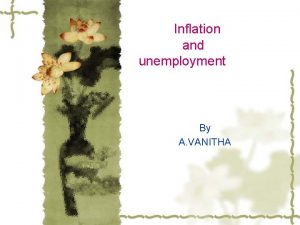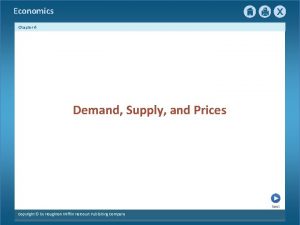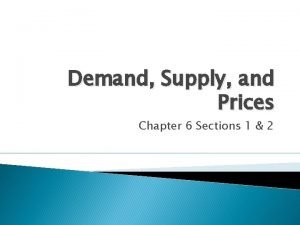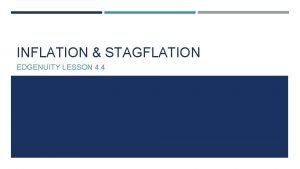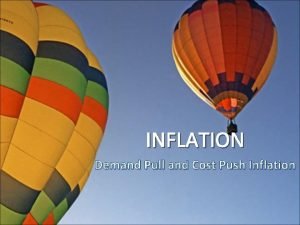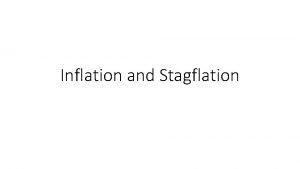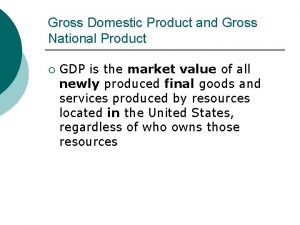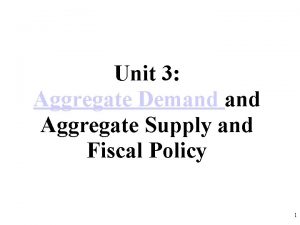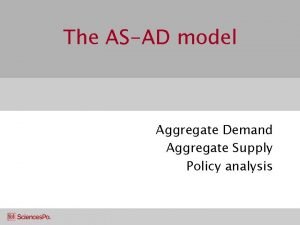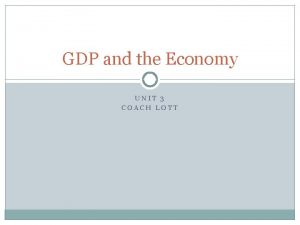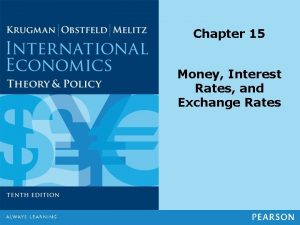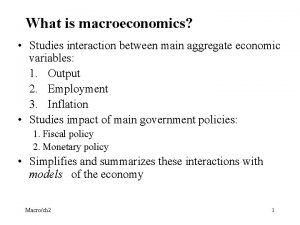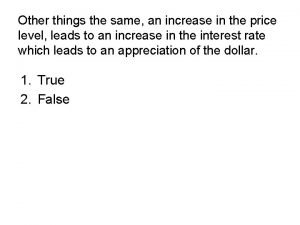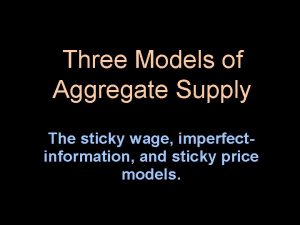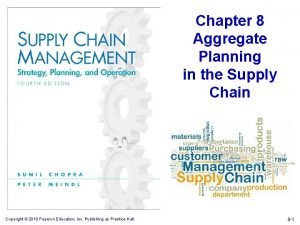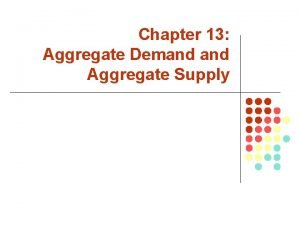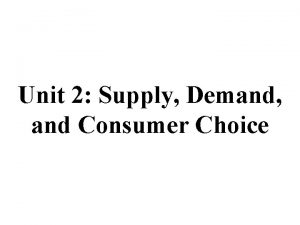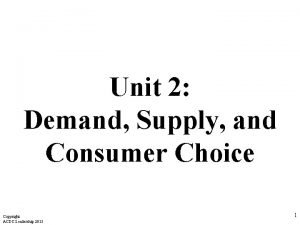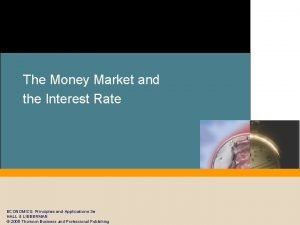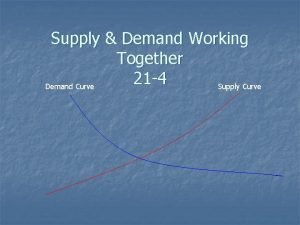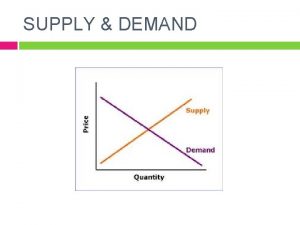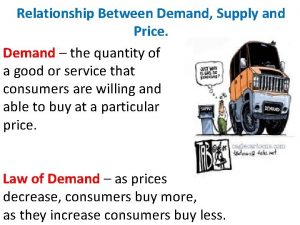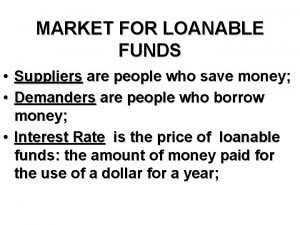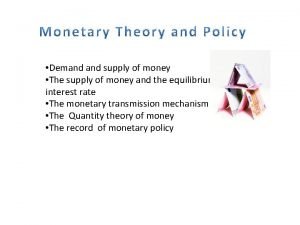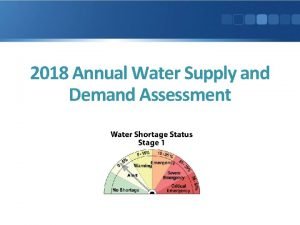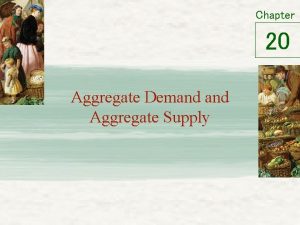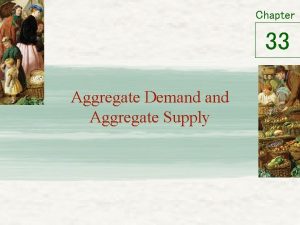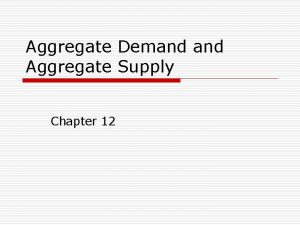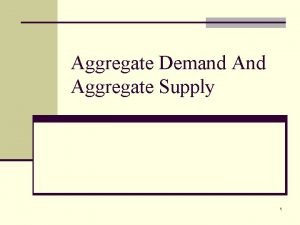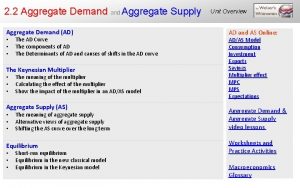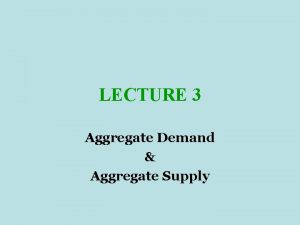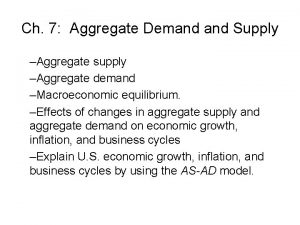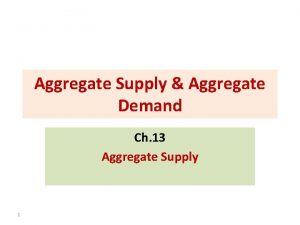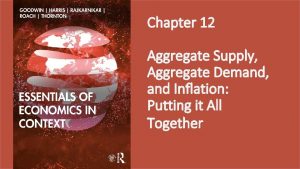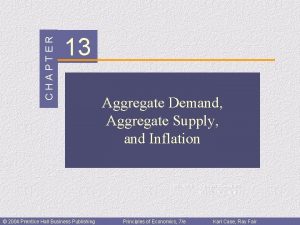Chapter 13 Aggregate Supply Aggregate Demand and Inflation


























































- Slides: 58

Chapter 13 Aggregate Supply, Aggregate Demand, and Inflation: Putting It All Together © Dünhaupt, Dullien, Goodwin, Harris, Nelson, Roach, Torras

Learning goals § After today‘s lecture, you will be able to: – Explain the derivation of the Aggregate Demand curve relating inflation and output levels, and how it shifts. – Explain the derivation of the Aggregate Supply curve relating inflation and output levels, and how it shifts. – Use the AS/AD model to describe the consequences of changes in fiscal policy, monetary policy, supply shocks, and investor and consumer confidence, depending on whether an economic is in a recession or at full employment. – Apply the AS/AD model to understanding major European macroeconomic developments of the last several decades. – Discuss how classical and Keynesian economic theories differ in how they understand the macroeconomy. Chapter 13 2

Chapter outline Aggregate Expenditure and Inflation 2. Capacity and the Aggregate Supply Curve 3. Putting the AS/AD Model to Work 4. Competing Theories 1. Chapter 13 3

Aggregate Expenditure and Inflation

From the AE-curve to the AD-curve Reminder: The AE-curve has shown us points at which points investment and savings are in equilibrium (I=S) § However, this is not the end of the story § – As discussed in chapter 12, ECB will react to inflationary pressures with higher interest rates – Higher interest rates lead to lower equilibrium AE § Solution: Another curve in a new diagram: The AD curve – AD curve shows link between inflation and aggregate demand, including ECB reaction Chapter 13 5

Reminder: Figure 12. 6 The ECB’s reaction function Inflation rate (π ) ü As the ECB’s primary objective is to keep inflation low and stable, it will react to increases in inflationary pressure with hikes in its main refinancing rate π1 If inflation rises… A π0 B r 0 …the ECB increases interest rates r 1 Interest rate (r) Chapter 12 6

How is inflation impacting on aggregate demand? § Mechanism A: For economies with § Mechanism B: For economies their own central bank and floating without their own central bank (e. g. exchange rates (e. g. the whole euro the single member states of the euro area, the US, Japan etc. ): area): – if inflation increases (decreases), central bank will increase (decrease) interest rates – this will dampen (increase) aggregate demand – ECB looks at the overall inflation rate in the euro area – small countries not likely to have impact on ECB’s interest rate decision – But: higher inflation reduces competitiveness of exports – Result: Higher inflation leads to less aggregate demand Chapter 13 7

13. 1 The Aggregate Demand curve ü This analysis shows the impact of different inflation levels on Aggregate Demand. Inflation rate (π ) …the level of Aggregate Demand falls B π1 If inflation rises… A π0 Y 1 Y 0 Output (Y ) Chapter 13 8

What determines the position of the AD curve? § specific levels of – government spending – taxation – autonomous consumption – autonomous investment – autonomous net exports Ø changes in these variables will cause the AD curve to shift Chapter 13 9

13. 2 The Effect of Expansionary Fiscal Policy or Increased Confidence on the AD curve Inflation rate (π ) ü If government spending increases, taxes decrease, consumers or investors become more confident, or net exports increase, demand for goods in the economy AD 1 AD 0 Output (Y ) Chapter 13 10

What happens if central banks change their policy? § active form of central bank intervention: – changing inflation target – focus on fighting unemployment same level of inflation would result in higher (lower) real interest rates set by the central bank Ø dampening (increasing) investment and shift the AD curve Ø Chapter 13 11

Capacity and the Aggregate Supply Curve

13. 3 The Aggregate Supply curve Inflation rate (π ) ü As the economy approaches its maximum capacity, inflation levels tend to rise as excessive demand for workers, goods and services, and production inputs pushes up wages and prices. Wage. Price Unemployment Spiral Aggregate Supply (AS) Maximum Capacity Y* Chapter 13 Output (Y ) 13

The Aggregate Supply curve at high output levels maximum capacity output: the level of output an economy would produce if every resource in the economy were fully utilized § wage-price spiral: when pressure on wages creates upward pressure on prices and, as a result, further upward pressure on wages § At maxiumum capacity, inflation levels tend to rise § Chapter 13 14

13. 4 The effect of an increase in inflationary expectations on the aggregate supply curve Inflation rate (π ) ü If people come to expect higher inflation, these expectations get built in to wage and price contracts, leading to a generally higher level of inflation throughout the economy. 5 % - AS 1 3 % - AS 0 Output (Y ) Chapter 13 15

Shifts of the AS curve: inflationary expectations if people expect higher inflation, expectations get built into wage and price contracts § Inflation can be self-fulfilling § in the short run: inflation rate the same as in the past § in the medium run: a rise in inflation tends to increase people’s expectations § Chapter 13 16

Shifts of the AS curve: supply shocks supply shock: a change in the productive capacity of an economy § e. g. bumper crop in agriculture, new invention, increase in labor productivity § the real capacity of the economy expands Ø the economy can produce more than before note: there can also be adverse supply shocks § e. g. natural occurrences or war Ø reduce economy’s capacity to produce § Chapter 13 17

Figure 13. 5 A beneficial supply shock: expansion of output capacity Inflation rate (π ) ü An expansion of output capacity could be a result of new technology or improved labor productivity AS 0 Expansion of Maximum Capacity AS 1 Output (Y ) Chapter 13 18

Putting the AS/AD Model to Work

The AS/AD model illustrates three points about the macroeconomy 1. fiscal and monetary policies affect output and inflation – expansionary fiscal and monetary policies tend to push the economy toward higher output. If the economy is approaching its maximum capacity, they will also cause inflation to rise. – contractionary fiscal and monetary policies tend to push the economy toward lower output. Inflation is unlikely to fall quickly, but a persistent recession will tend to lower inflation over the long term. Chapter 13 20

The AS/AD Model illustrates three points about the macroeconomy (cont. ) 2. 3. supply shock may have significant effects – adverse supply shocks lower output and raise inflation – beneficial supply shocks raise output and lower inflation investor and consumer confidence and expectations have important effects on output and inflation Chapter 13 21

We will now apply the model to a number of cases 1. 2. 3. 4. 5. An economy in recession Stagflation in the 1970 s and 1980 s A hard line against inflation: Disinflation in the 1980 s An overheated economy: The German reunification Austerity policies and structural reforms Chapter 13 22

Case 1: The global financial and economic crisis 2008 -2009 unemployment was high but inflation remained low § governments of major OECD countries passed stimulus packages with tax cuts and spending increases § stimulus packages helped European economies to recover from recession § – effects not large enough to reach full employment – inflation did not rise Chapter 13 23

13. 6 Aggregate Demand supply equilibrium in recession Unemployment Inflation rate (π ) AS ü The position of the AD curve indicates a low level of aggregate demand, leading to an economy with unemployment at equilibrium E 0. At this point on the AS curve, inflationary pressures are low. E 0 AD Output (Y ) Y* Chapter 13 24

Figure 13. 7 Expansionary fiscal policy in response to a recession Unemployment Inflation rate (π ) AS E 1 E 0 AD 0 ü An expansion of government spending, as well as a program of tax cuts, shifts the AD curve to the right. This reduces unemployment, but since the economy is in the flat portion of the AS curve at equilibrium E 1, it has little effect on inflation. AD 1 Y* Chapter 13 Output (Y ) 25

The reaction in the U. S. was different Fed embarked early on quantitative easing § idea: combination of monetary expansion plus recovering confidence of consumers and businesses leads to a more complete recovery § larger shift in AD brings economy back to full-employment § Chapter 13 26

Figure 13. 8 A greater expansion of aggregate demand Unemployment Inflation rate (π ) AS E 1 E 0 AD 0 ü If Aggregate Demand increases by a larger amount, it can bring the economy back into the full employment zone. At equilibrium point E 1 the AS/AD model indicates the possibility of a slightly higher inflation level. AD 1 Y* Chapter 13 Output (Y ) 27

Case 2: Stagflation Prelude: The 1950 s and 1960 s robust economic growth and low unemployment § inflation under control § believe: trade-off between unemployment and inflation § Chapter 13 28

Inflation (percent per year) 13. 9 The Phillips Curve for the U. S. in the 1960 s 6 5 ü In the 1960 s economist A. W. Phillips identified an inverse relationship between inflation and unemployment. While this basic relationship still holds true, events of the 1970 s and later showed that inflation can be much more variable than the simple Phillips principle implies. 1969 1968 4 1967 3 1966 2 1965 1964 1963 1 0 0 1 2 3 4 5 6 7 8 Unemployment Rate (percent) Chapter 13 29

The 1970 s increase in inflation and unemployment § 1973 -1974: “oil-price shock” § stagflation: a combination of rising inflation and economic stagnation § How can we explain this effect ? Chapter 13 30

13. 10 The effect of the oil price shock of the 1970 s Inflation rate (π ) ü A drastic increase in the price of a key resource reduces the economy’s total capacity and shifts the AS curve up and to the left. Both inflation and unemployment get worse at equilibrium point E 1. AS 1 E 1 AS 0 E 0 AD Lower Capacity Chapter 13 Output (Y ) 31

Figure 13. 11 a: German inflation and unemployment, 1969 -1975 ü The oil price shock of the 1970 s pushed inflation in Germany only up a few percentage points and price pressure quickly subsided again. However, unemployment more than doubled. 20 18 16 percent 14 12 10 8 Inflation 6 4 Unemployment 2 0 1969 1970 1971 1972 Chapter 13 1974 1975 Source: AMECO database, 2016. 32

Figure 13. 11 b: Italian i. Inflation and unemployment, 1969 -1975 ü In Italy, inflation surged during the oil price shock of the 1970 s. However, unemployment remained almost unaffected. 20 18 16 percent 14 12 Inflation 10 8 Unemployment 6 4 2 0 1969 1970 1971 1972 Chapter 13 1974 1975 Source: AMECO database, 2016. 33

How can we explain these different outcomes using our AS/AD Model? § Germany: – Inflation increased during oil-price shock – German Bundesbank increased interest rates – increase in inflation and unemployment § Italy: – increase in public spending – expansionary monetary policy to finance part of government expenditure – higher inflation but no increase in unemployment Chapter 13 34

Inflation rate (π ) 13. 12 The Italian reaction to oil price shock of the 1970 s AS 1 E 2 E 0 AS 0 AD 1 ü Initially, the oil price shock has led to increased unemployment and higher inflation (a movement from E 0 to E 1). Yet, the Italian government reacted with expansionary fiscal and monetary stimulus which pushed inflation further up (to E 2). Lower Capacity Chapter 13 Output (Y ) 35

This was not the end of inflation in the 1970 s … § in countries like Italy, inflationary expectations permanently shifted upward – expectation of higher inflation built into wage and price contracts – permanently high inflation rate § in countries like Germany and Switzerland, inflation came down by 1978 Chapter 13 36

1980: tight monetary policy § Situation in the U. S. : – high inflation led to people’s discontent – Remember: high rates of inflation can wipe out people’s savings and make it difficult to plan, save, and invest – U. S. central bank, the Federal Reserve, under Paul Volcker, implemented very contractionary monetary policies most European central banks followed and increased interest rates § Result: Fall in inflation, but long recession and increase in unemployment § Chapter 13 37

13. 13 The effects of The Fed’s “tight money” policies in the 1980 s Inflation rate (π ) Unemployment AS 0 E 1 AS 1 E 2 AD 0 AD 1 Y* ü A very restrictive monetary policy drives the AD curve sharply to the left, pushing unemployment to very high levels. But a resulting decrease in inflationary expectations shown in aggregate supply curve AS 1 lowers inflation and allows the economy to recover to equilibrium point E 2. Output (Y ) Chapter 13 38

Disinflation in the early 1980 s media reports on the commitment of central banks to bring inflation down § inflation expectations fell over time § But: significant human and economic cost § – Unemployment stayed higher for long in Europe than in the U. S. Chapter 13 39

How can one explain different performance in the U. S. and Europe? ü inflexible European labor market ü firms reluctant to hire new workers due to legal difficulties to get rid of them if business declines ü it takes a long time of economic growth before firms start hiring and unemployment falls ü unemployed workers loose skills ü cyclical unemployment turns into structural unemployment ü lower potential output Chapter 13 ü central bankers did not lower interest rates enough ü excessively tight monetary policies limited speed of Europe’s recovery ü Past experience: fear of inflationary expectations which can only be reduced by policies that cause economic pain 40

Case 4: Inflation can also be caused by an overheated economy and an excess of aggregate demand § German reunification boom in the early 1990 s – additional demand for consumer goods – increase in confidence of West German firms – huge public investment program Chapter 13 41

13. 14 Excessively high aggregate demand causes inflation Wage. Price Spiral Inflation rate (π ) AS E 1 E 0 AD 1 ü Expansionary policy causes the economy to “heat up. ” In the short run, people respond by increasing output, but tight markets for labor and other resources cause inflation to rise as well at equilibrium point AD 0 Y* Chapter 13 Output (Y ) 42

What happened next? § German economy hit by negative shocks – Bundesbank increased interest rates sharply – consumer and investor confidence decreased – 1992: European Monetary System crisis – decline in German exports – decline in inflation, rise in unemployment Chapter 13 43

Case 5: Austerity policies and structural reforms § euro-crisis: austerity packages and structural reforms – from 2010, investors got concerned about debt sustainability – high interest rates for borrowers – EU: cut public spending, increase taxes, and implement structural reforms Chapter 13 44

Figure 13. 15 a A loss of investor confidence in the AS/AD model Inflation rate (π ) ü When investors lose confidence in one country and cut credit lines to the countries’ firms, the AD curve shifts left. GDP contracts and unemployment increases. AS 0 E 2 E 0 E 1 AD 2 AD 1 AD 0 Chapter 13 Output (Y ) 45

Figure 13. 15 b Structural reforms in the AS/AD model Inflation rate (π ) ü If the government reacts to the fall in output with reforms which increase potential output, in a second step, the AS curve shifts right. GDP increases again, but prices fall. It is not clear, however, whether a return to the initial GDP level is possible. AS 0 AS 1 E 0 E 2 E 3 AD 2 Chapter 13 AD 0 Higher Capacity Output (Y ) 46

Figure 13. 16: Unemployment in Ireland Greece ü During the euro crisis, unemployment both in Ireland Greece was significantly above pre-crisis levels. However, as of 2016, unemployment in Ireland has come down significantly, while it has remained stubbornly high in Greece. 30 Greece 25 percent 20 15 Ireland 10 5 0 2011 2012 2013 Chapter 13 2014 2015 Source: Eurostat, 2016. 47

Figure 13. 17: Inflation in Ireland Greece ü Inflation fell both in Ireland Greece after austerity packages and structural reform measures were enacted. However, inflation fell further in Greece than in Ireland. 3 2 1 percent Ireland 0 2012 2013 2014 2015 2016 -1 Greece -2 -3 Source: Eurostat, 2016. -4 Chapter 13 48

Figure 13. 18 a Macroeconomic results of austerity and structural reforms in Ireland Inflation rate (π ) ü As Ireland is a very open economy, falling inflation caused by structural reforms boosted exports and aggregate demand. As a consequence, structural reforms were able to counteract part of the negative impacts of austerity. AS 0 AS 1 E 2 E 0 E 3 AD 2 Chapter 13 AD 0 Higher Capacity Output (Y ) 49

Figure 13. 18 b Macroeconomic results of austerity and structural reforms in Greece Inflation rate (π ) ü As aggregate demand in Greece does not react much to changes in inflation, structural reforms have not been able to increase employment significantly. The combination of austerity and structural reforms has led to lower inflation, but also high unemployment. AS 0 AS 1 E 0 E 2 E 3 AD 2 AD 0 Chapter 13 Higher Capacity Output (Y ) 50

Competing Theories

Was it necessary to enact expansionary scal policy in order to get the European economies out of the 2008– 2009 recession? Was it a good idea for the ECB to lower interest rates to zero (and below for deposits) in 2015– 2016 to try to promote recovery? Chapter 13 52

Classical macroeconomics § assumptions: – self-adjusting properties of free-markets – labor markets clear at an equilibrium wage – markets for loanable funds cause savings and investment to be equal at an equilibrium interest rate Ø in theory, a smoothly functioning economy should be at full-employment Chapter 13 53

13. 19 The classical view of AS/AD Inflation rate (π ) ü the vertical AS curve represents the classical view that the economy will tend to return to full employment automatically. Classical AS AD Output (Y ) Y* Chapter 13 54

The classical view of AS/AD § AS curve at full-employment level – people make optimizing choices – unemployed workers bid down wages – full-employment restored § AD level determines only the inflation rate Chapter 13 55

What is the effect of aggregate demand-management policies? expansionary fiscal or monetary policy has no effect on the output level § government spending “crowds out” private spending § – more spending by government means less spending by consumers and businesses § monetary expansions lead only to increased inflation – central bank should choose a certain growth rate of the money supply or level of the interest rate Chapter 13 56

Keynesian macroeconomics market economies are inherently unstable § business cycles can be explained by changes in investors’ confidence § macroeconomic phenomena cannot be explained by assuming rational, optimizing behavior by individuals § inherent tendency toward market instability requires active government intervention § Chapter 13 57

What to take home § § § higher inflation rates tend to reduce aggregate demand, as central banks increase interest rate fiscal and monetary policies affect output and inflation supply shock may have significant effects investor and consumer confidence and expectations have important effects on output and inflation Classical and Keynesian economists provide different arguments about economic analysis and policy Chapter 13 58
 Sras lras
Sras lras Ad curve graph
Ad curve graph Unit 3 aggregate demand aggregate supply and fiscal policy
Unit 3 aggregate demand aggregate supply and fiscal policy Tax multiplier formula
Tax multiplier formula Unit 3 aggregate demand aggregate supply and fiscal policy
Unit 3 aggregate demand aggregate supply and fiscal policy Introduction of inflation
Introduction of inflation Aggregate supply and demand graph
Aggregate supply and demand graph Aggregate supply and demand graph
Aggregate supply and demand graph Aggregate planners seek to match supply and demand
Aggregate planners seek to match supply and demand Module 5 supply and demand introduction and demand
Module 5 supply and demand introduction and demand Long run aggregate supply curve
Long run aggregate supply curve Matching supply with demand
Matching supply with demand Tableau cannot mix aggregate and non aggregate
Tableau cannot mix aggregate and non aggregate 5 determinants of supply
5 determinants of supply Chapter 6 section 2 supply and demand in everyday life
Chapter 6 section 2 supply and demand in everyday life Chapter 6 demand supply and prices
Chapter 6 demand supply and prices Chapter 6 supply demand and government policies
Chapter 6 supply demand and government policies Chapter 5 section 1 supply
Chapter 5 section 1 supply Ypically, high inflation is a sign of
Ypically, high inflation is a sign of Inflation causes and effects
Inflation causes and effects Cost push inflation
Cost push inflation Stagflation definition
Stagflation definition Gross private domestic investment includes
Gross private domestic investment includes Inflation
Inflation Why is aggregate demand downward sloping
Why is aggregate demand downward sloping Aggregate supply equation
Aggregate supply equation Dad curve equation
Dad curve equation Aggregate demand curve
Aggregate demand curve Recessionary gap aggregate demand
Recessionary gap aggregate demand The aggregate real money demand schedule l(r,y)
The aggregate real money demand schedule l(r,y) The aggregate real money demand schedule l(r,y)
The aggregate real money demand schedule l(r,y) Expansionary monetary policy
Expansionary monetary policy Real gdp formula
Real gdp formula Aggregate demand graph
Aggregate demand graph Which of the following shifts aggregate demand to the left?
Which of the following shifts aggregate demand to the left? Measures to correct excess and deficient demand
Measures to correct excess and deficient demand Independent demand inventory system
Independent demand inventory system Schedule ng supply
Schedule ng supply Types of demand forecasting in managerial economics
Types of demand forecasting in managerial economics Paradox of value
Paradox of value Independent demand inventory system
Independent demand inventory system What is sticky wage model
What is sticky wage model Aggregate planning in supply chain management
Aggregate planning in supply chain management The aggregate supply curve is
The aggregate supply curve is Aggregate supply shifters
Aggregate supply shifters Aggregate supply curve
Aggregate supply curve Which aggregate supply curve has a positive slope
Which aggregate supply curve has a positive slope Unit 2 demand supply and consumer choice
Unit 2 demand supply and consumer choice Unit 2 demand supply and consumer choice
Unit 2 demand supply and consumer choice Money market equilibrium
Money market equilibrium Combining supply and demand worksheet
Combining supply and demand worksheet Interaction of demand and supply
Interaction of demand and supply What is the relationship between supply and price
What is the relationship between supply and price Who are the suppliers of loanable funds
Who are the suppliers of loanable funds Shifters of supply for loanable funds
Shifters of supply for loanable funds Supply and demand economics project
Supply and demand economics project Money supply curve
Money supply curve Supply demand rule
Supply demand rule Annual water supply and demand assessment
Annual water supply and demand assessment





